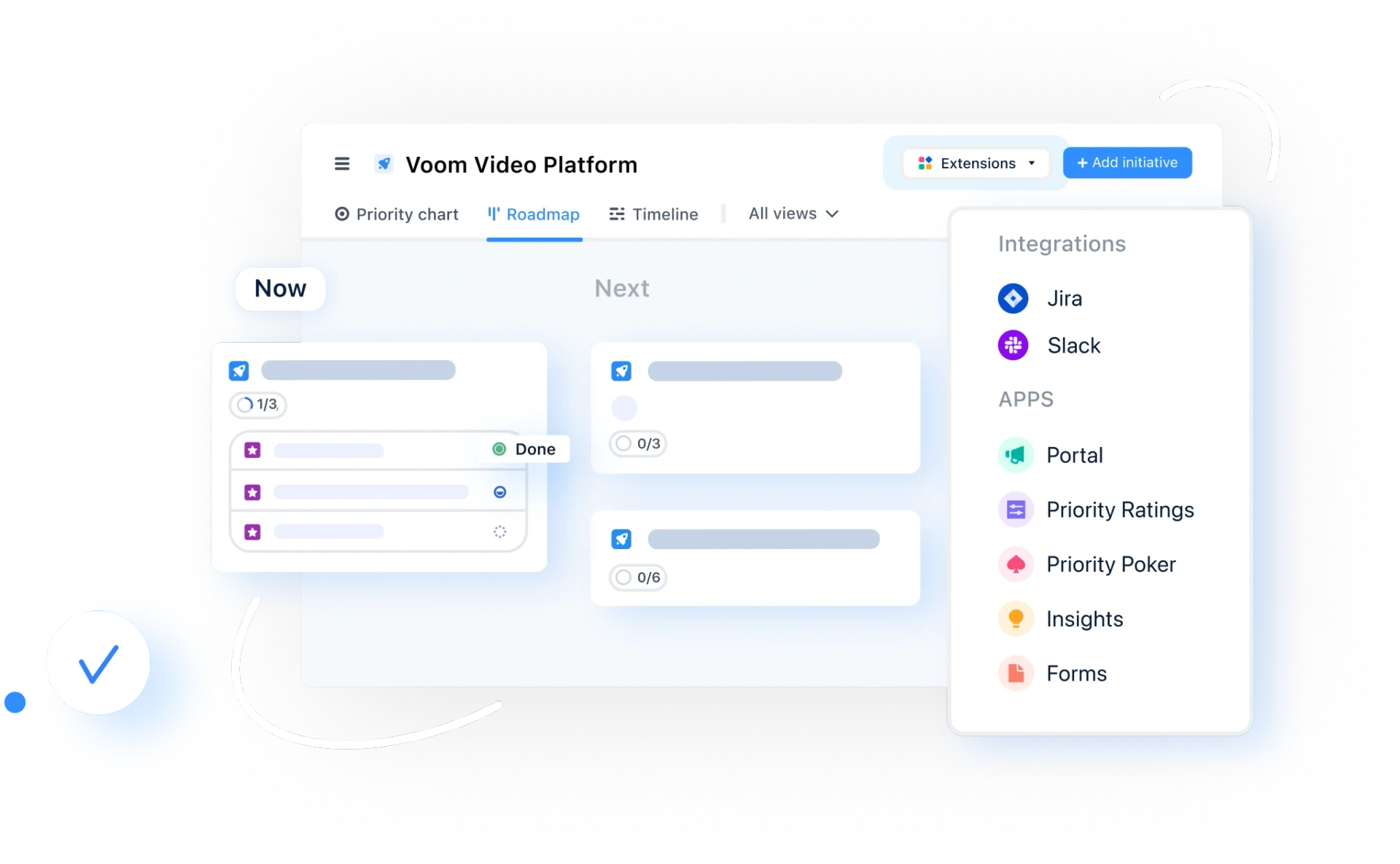
Are you tired of endless to-do lists and struggling to prioritize items for your team's products or projects? Look no further! In 2024, there are more prioritization software tools than ever before, and we've compiled a list of the best ones to help you and your team stay on track and build products that truly add value to your customers.
Don't miss out on this opportunity to supercharge your productivity and streamline your product development team's prioritization process. Check out our list of the best prioritization software tools in 2024!
TL;DR
Tired of endless to-do lists? Prioritization software can help streamline your product development process.
A survey by Mind The Product showed that 64% of PMs spend hours each week prioritizing tasks, while 7% spend no time at all on prioritization.
Prioritization tools help create roadmaps, align teams, and keep stakeholders informed.
The right prioritization tool is crucial for successful product management.
Benefits of prioritization software:
Centralize feedback and align teams.
Use frameworks like RICE, MoSCoW, Value vs. Effort and weighted decision-making.
Improve communication and collaboration.
Track progress and adapt to changes.
Choose software that integrates well, offers built-in tools, and supports scalability.
The benefits of using product prioritization tools for product teams
According to Mind the Product, 64% of respondents dedicate at least a few hours each week to prioritizing tasks. Surprisingly, 7% spend no time on prioritization at all.
Using prioritization tools, you can create a roadmap and schedule that can provide a timeframe for other departments to align their marketing and release efforts.
The outcomes of a prioritization session can also be shared with stakeholders to ensure they are kept up-to-date and understand the development team's current priorities.
Additionally, prioritization tools can help you keep customers informed about potential timelines, making the customer management process easier and more efficient.
How to master prioritization process and why software helps
Many think that prioritization process is an easy job, but it's not a superpower.
It takes experience and practice to become truly great at prioritization in a way that adds value to each and every project. There's a lot to be said about the human brain and its ability to prioritize. But to create successful products, we all need a helping hand.
This is why choosing the right prioritization tool is so important. Prioritization software makes it easy for your teams to align themselves around the right objectives and goals during development. There are many different prioritization frameworks out there, including, the weighted decision-making prioritization matrix, and RICE.
No matter what prioritization framework you use, choosing the right software will help you communicate with and align your teams.
So let's not waste any time and dive straight into our list of the best prioritization software in 2024!
The best prioritization tools for 2024
1. airfocus
airfocus is the first modular product management tool that combines ease of use with extremely powerful prioritization tools to help you build the best possible product. The extremely flexible and scalable platform is packed full of features that will ensure your teams are ready for the future of product management.
airfocus helps you deliver value faster with a range of tools to help you accelerate your time to market. Teams using airfocus can easily outpace your competitors with a centralized place for all your product work. You can build dynamic and strategic product roadmaps without the stress and complications of other platforms.
Teams that use airfocus don't need to adapt to how the platform wants them to work. Everything can be set up exactly how you want it to work with customer scoring systems and plenty of different ways to visualize the project, including Kanban, charts, timelines, and more.
Everyone involved in the product development process — from devs to stakeholders — can be aligned through a unique and customizable portal. airfocus Portal lets you share roadmaps, plans, and launches with your audiences, complete with your own branding. Meanwhile, your audience can submit feedback directly with a simple, built-in feedback tool.
(Checkout this product roadmap template to start with).
The platform offers a huge range of fully customizable prioritization templates built on proven product management and decision-making frameworks. It doesn't matter if your team is using Value vs. Effort, RICE, WSJF, MoSCoW, ICE, or any other framework — airfocus adapts to you, not the other way around.
Get started with airfocus for free today with a 14-day trial, no credit card required!
airfocus AI Assist
We decided it was time to put AI to work for product managers worldwide, giving them a smoother and faster experience that allows everyone to focus on value.
Sometimes it's difficult to know where to start and even more difficult to keep going mid-way through development. This is where an AI assistant can improve your product management, your product, and even your day-to-day life. After all, less on your plate means less time management stress!
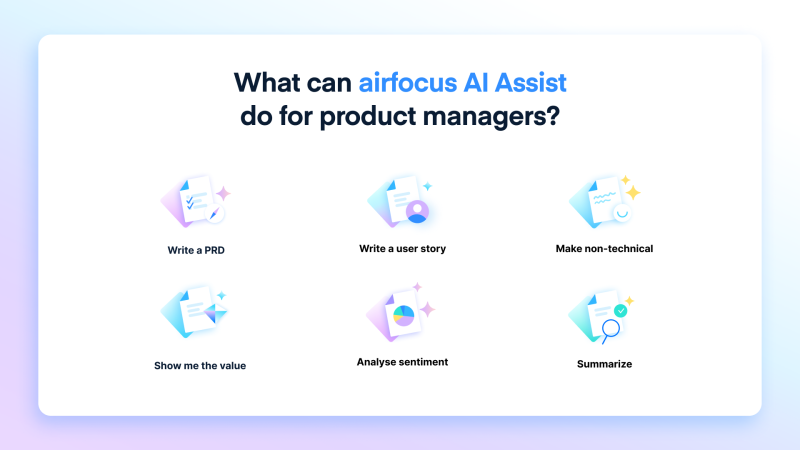
You can use AI Assist by airfocus to quickly generate ideas, or even a first draft so that your first blank page doesn't stay blank.
You can also let AI Assist take care of feedback analysis to help you see what users need without manually looking through every piece of user feedback yourself. All this with simple slash commands. It really couldn't be easier.
Rating: G2 - 4.4 stars.
Demos: You can have an instant tour on your own or book a demo on the website.
Pricing: Plans start at $69 per editor per month.
Free trial: Yes.
Pros
Lets you create customization scoring frameworks.
Every prioritized item is given a final score and gets mapped on a simple-to-understand chart.
Huge range of templates to help you get started within minutes.
Modular platform — it adjusts to what you actually need!
Fun online priority poker game lets stakeholders weigh the impact and effort of items in the product backlog.
Unified product operating system for your products.
Link product work to OKRs and thus prioritize the right things to achieve your goals.
Can track the progress of multiple teams.
Cons
Call us biased, but we don’t think airfocus has any cons 😉
2. Jira
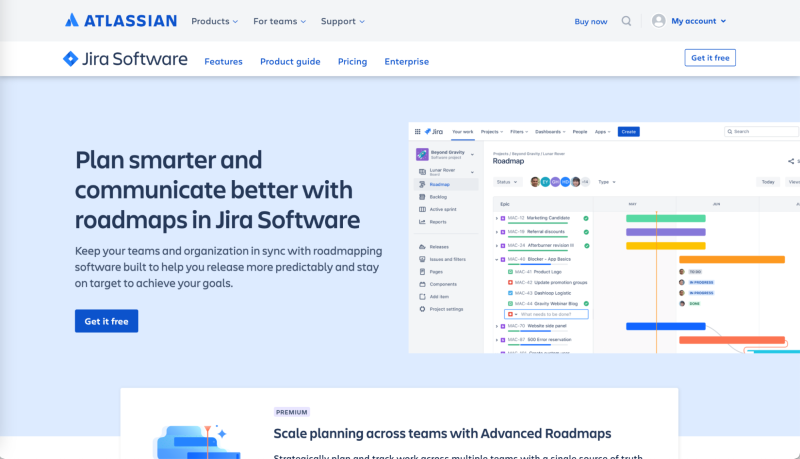
Jira is one of the most well-known SaaS platforms in product management. Developed by Australian software developers Atlassian, Jira is a one-size-fits-all solution for product management in every industry.
Having started as a simple bug and issue tracker, Jira has transformed itself into a product management platform with all the bells and whistles you could ever need. They pride themselves as “The #1 software development project management tool used by agile teams”, and it's easy to see why.
Jira leverages many project management tools to help teams manage stakeholders, budgets, and feature requests and requirements, and much more. It's a user-friendly platform that can add value to any product development team.
Jira features a highly flexible layout to fit any agile workflow and several report styles to help push data-driven retrospectives. This allows product managers an impartial view of what's working and what needs to be improved.
Unfortunately, Jira has no built-in prioritization tools. Even basic prioritization scoring will require an add-on. The upside of this is that teams can choose from a range of prioritization scoring add-ons. This means they can work with frameworks they already know.
Ratings: G2 - 4.3 stars.
Demos: Project Management with Jira | Atlassian.
Pricing: Plans start at $8.15 per user per month.
Free trial: Yes, for up to 10 users.
Pros
Well-known tool.
New starters will likely know and understand how to use the platform.
You can use Jira to plan, track, and prioritize your entire product roadmap.
Cons
Jira has no built-in prioritization tools, so you’ll need to use third-party add-ons.
3. Miro
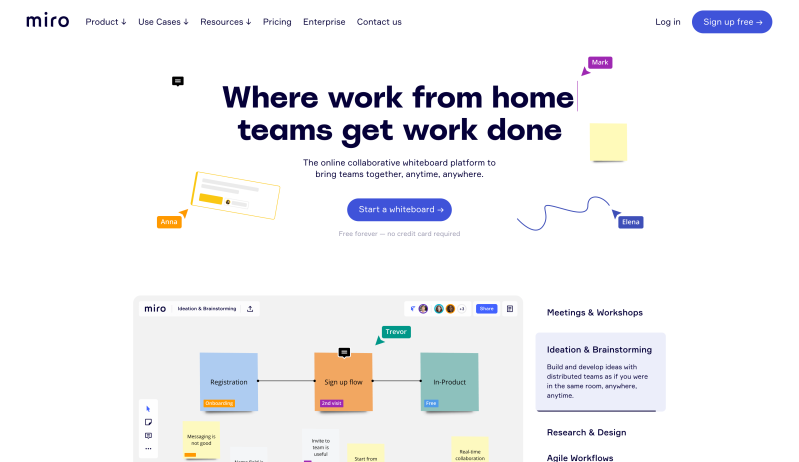
Miro is an online whiteboard platform that helps remote and hybrid teams collaborate with ease. It's highly flexible and has a simple-to-use interface that allows teams to create ideation lists and wireframes, develop user stories, lay out roadmaps, or simply jazz up team meetings.
The platform allows you to create notes and designs that can be moved around in real-time during a video chat. Since it's cloud-based, everyone can access the whiteboard through any device in any location, making it a perfect collaboration tool for remote and hybrid teams.
Miro has no built-in prioritization frameworks. However, it offers many custom-built templates by both Miro and its users in the “Miroverse.” Miro's own templates include SWOT analysis, MoSCow, RICE, Kano, Ansoff, Fibonacci Scale, Eisenhower Matrix, and many more templates to help teams prioritize items.
Ratings: G2 - 4.8 stars.
Demo: No.
Pricing: You can start with a basic plan for free, packages start at $10 per user per month.
Free trial: Yes.
Pros
The cloud-based platform has been designed with remote work in mind.
Helps remote teams plan everything together, including prioritization.
Cons
While Miro can be used for prioritization, it’s not great for heavy-duty prioritization.
4 . Craft
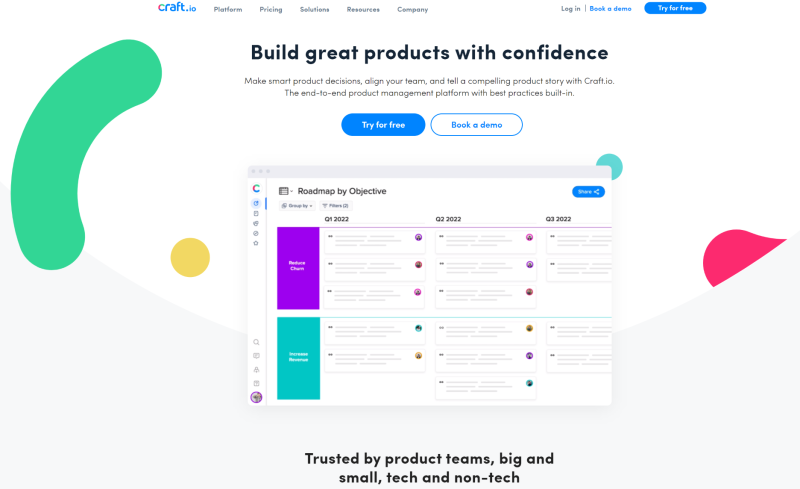
Craft has been built from the ground up to offer product managers a powerful and intuitive way to define, plan, and manage their product development strategies. The platform can handle almost everything you can throw at it, from capturing feedback and discovery to roadmapping and collaboration.
Every feature Craft.io offers has been handpicked and developed with care to ensure it provides real value to its users. It empowers product managers to unlock maximum potential with powerful data organization and a great range of prioritization tools to fit any framework.
The platform has WSJF, RICE, and MoSCoW baked right into it, so you can get right to work without searching for third-party add-ons or messing with spreadsheet formulas. Not satisfied with the built-in frameworks? Craft.io allows you to create your own prioritization model with unlimited custom fields and the ability to score items however you please.
Ratings: G2 - 4.5 stars.
Demos: You can book a demo on the website.
Pricing: Plans start at $19 per user per month.
Free trial: Yes.
Pros
Plenty of sharing features for easy collaboration.
Great selection of integrations.
Cons
Starting at $39/per user per month, Craft.io can get very expensive quickly.
The user interface can be tricky to navigate at first.
5. Trello
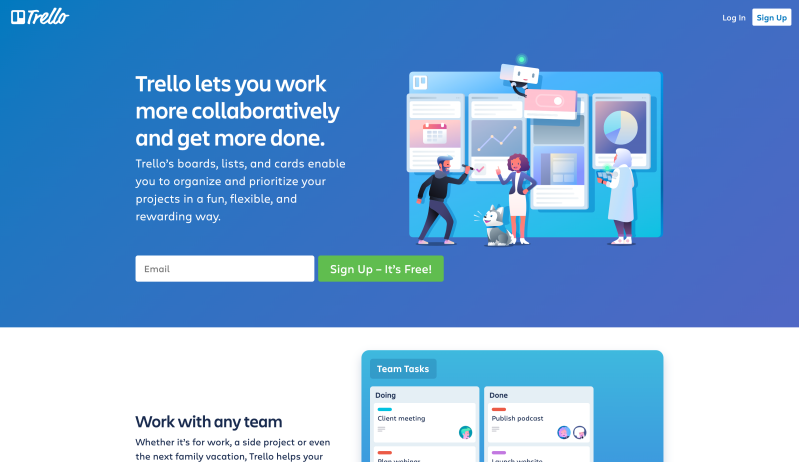
Another offering from Atlassian, is a cloud-based visual tool that can help teams manage projects, workflows, and even track tasks. Trello takes the traditional Kanban board and makes it far more accessible to product teams. The platform offers real-time updates that connect workers whether they're working in the office, remotely, or on a hybrid schedule.
Trello makes it easy for teams to get started with Kanban-style boards thanks to its expansive template library. For those looking for something specific, the platform has a vast range of customization options to help your team work how they want to.
While Trello has no built-in prioritization features, it's still valuable to product teams thanks to its public-facing roadmapping features. There are also a range of add-ons (which they call Power-Ups) that can facilitate prioritization scoring.
Card Priority by Screenful is one such Power-Up that has become popular among Trello users who need prioritization tool. It's a simple and free add-on that allows teams to set priorities for their cards and runs entirely within the Trello UI.
Ratings: G2 - 4.4 stars.
Demos: Boost your productivity with Trello.
Pricing: Plans start at $5 per user per month.
Free trial: Yes.
Pros
Endless customization makes it easy for new users to get started their way.
Free plan available with no time or user limits.
Large template library to get started in seconds.
Cons
No built in-prioritization templates or frameworks.
Free plan has fairly limited functionality.
6. Asana
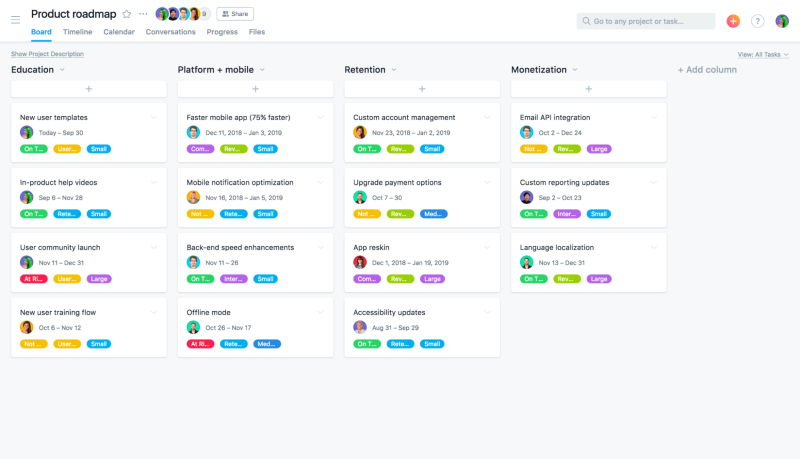
Asana helps with prioritization by letting you categorize tasks, set task dependencies, assign due dates and assignees complete tasks, and create custom fields for tasks. These features enable you to identify and focus on the most critical tasks first, and prioritize based on deadlines, team members' availability and skills, and specific criteria important to your team or project.
By using Asana's prioritization features, you can ensure that tasks are completed efficiently and effectively, avoiding procrastination and focusing on the most important work.
Ratings: G2 - 4.3 stars
Demo: Yes.
Pricing: For individuals and small teams, there is a free basic package, and the paid ones start at $13,45 per month.
Free trial: Yes.
Pros
Asana has some built in prioritization template functionality.
Good for prioritizing tasks.
Cons
Asana is more of a project management tool, so it may not be perfectly suited to product prioritization.
Very limited free plan.
Needs an internet connection to work.
7. Roadmunk
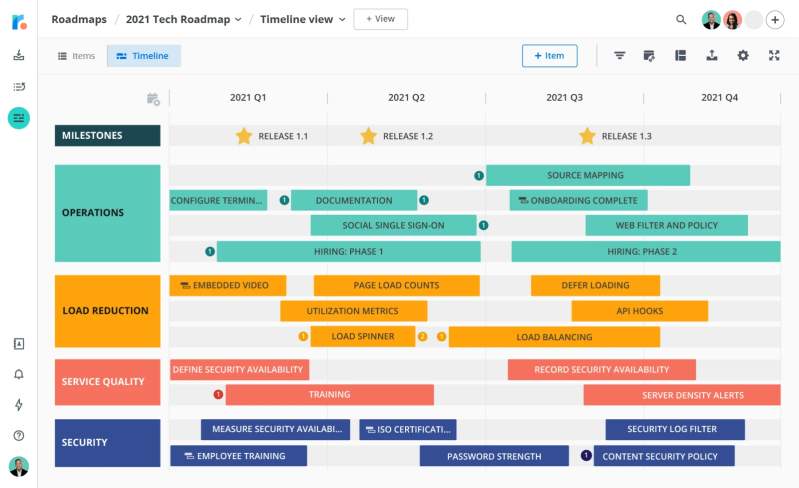
Roadmunk helps with prioritization by providing a visual roadmap for projects. It allows you to create different scenarios, compare them, and then prioritize tasks based on their impact on your goals.
The tool also lets you set up different priority levels for items on your roadmap and assign values to them based on their importance. While Roadmunk specializes in roadmaps, the platform also provides features like collaboration and communication tools, custom fields, and integrations with other tools to help teams make informed decisions about which tasks to prioritize.
Ratings: G2 - 4 stars
Demos: Learning Session: Roadmapping with Roadmunk - October 2023.
Pricing: Plans start at $19 per month.
Free trial: Yes.
Pros
Built-in templates and features for prioritization.
Flexible.
Can include customer feedback in your prioritization.
Cons
Product navigation is a little complicated.
Less customizable compared to others.
Collaboration can be difficult.
8. Aha!
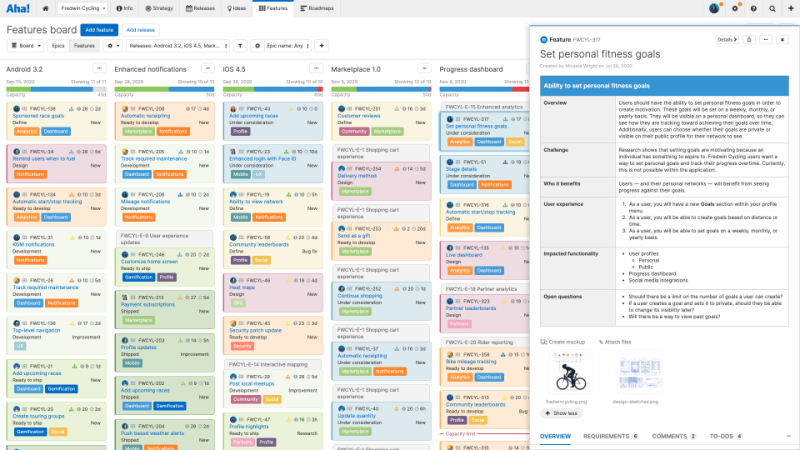
Aha has been helping product managers for a long time, and the platform continues improving with every update. Among their robust feature offerings is their feature and activity prioritization page.
The product prioritization tools' page offers a user-friendly platform to prioritize and manage tasks effectively. With filters, users can locate the tasks they want to prioritize, update product value scores directly, and reorder records according to their priority level by dragging and dropping them.
Ratings: G2 - 4.3 stars.
Demos: Aha! Roadmaps | Getting Started.
Pricing: Plans start at $59 per user per month.
Free trial: Yes.
Pros
Aha! is the oldest player in the product roadmap software game.
Custom prioritization scoreboard feature.
Very flexible.
Cons
Can get expensive.
Not the easiest platform to use.
9. Productboard
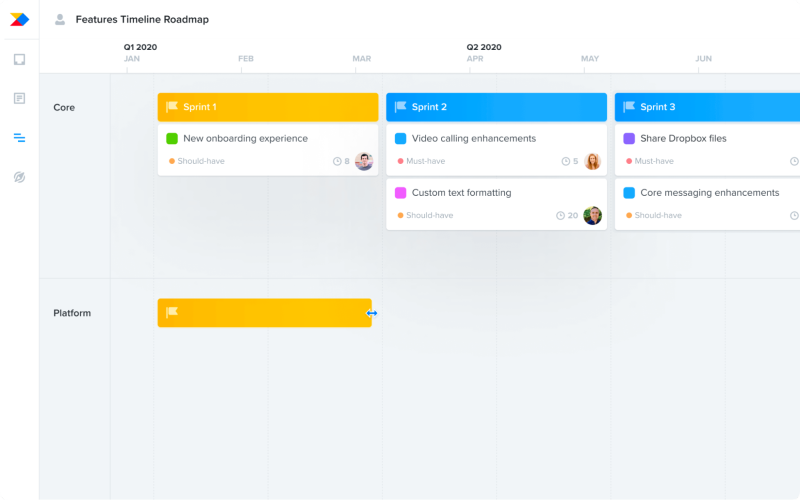
Productboard is a product management tool that pushes customer-centricity to the forefront of everything you do. The platform touts itself as “the only product management platform that provides a single source of truth for all customer data” and aims to help product teams identify crucial user needs.
The recent addition of AI to the platform has given users the chance to analyze feedback at scale and streamline processes to help them deliver meaningful products faster.
Rating: G2 - 4.3 stars.
Pricing: Free tier available, paid plans start at $19 per maker per month.
Free trial: 15-day trial of paid plans available.
Demo: Productboard Overview.
Pros
Clean UI.
AI assistance.
Flexible.
Centralized customer feedback.
Cons
Analytics could be more detailed.
Cannot filter notifications.
Roadmaps do not update in real-time.
Mobile app is lacking.
10. ProductPlan
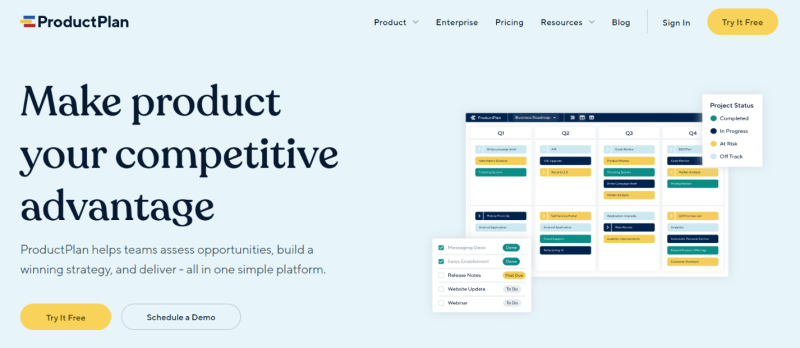
ProductPlan is a roadmapping platform that allows teams to own their product success and communicate product strategy through a single source of truth. Product teams can use ProductPlan to capture and organize ideas to influence product prioritization, collaborate with other teams, build and share clear, detailed roadmaps, and drive strategy.
Rating: G2 - 4.4 stars.
Pricing: Starts at $49 per editor per month.
Free trial: 14-day free trial of the basic tier.
Demo: A free live demo of the professional and enterprise tiers is available.
Pros
Easy to learn.
User-friendly interface.
Great customer service team.
Integrates well with Jira.
Cons
On the pricier side.
Roadmaps become cluttered when working with more lanes.
Could use more customization options.
Difficult to collaborate with non-paying accounts.
11. Scoro
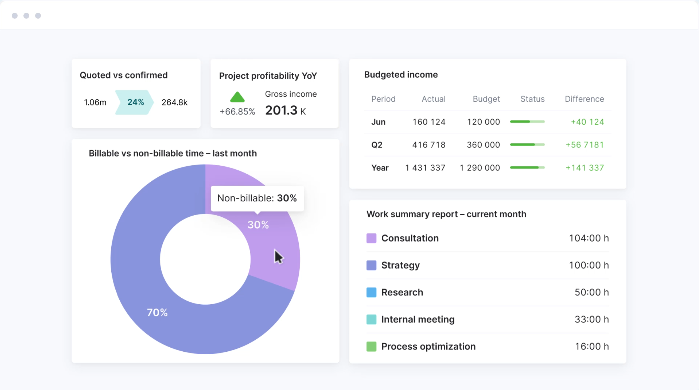
Scoro isn’t your standard product prioritization tool, it offers an all-in-one solution for businesses looking to manage projects, finances, and resources in a single platform. It offers in-depth reporting and CRM to help teams gather the necessary information to make effective prioritization decisions.
Rating: G2 - 4.5 stars.
Pricing: Starts at $26 per user per month.
Free trial: 14-day free trial on all tiers.
Demo: Scoro Walkthrough.
Pros
Manage your own business in one platform.
In-depth reporting.
Streamlines processes.
Good selection of integrations.
Cons
Steep learning curve.
Missing features.
Mobile app could be better.
Some tasks could be more reliable, like sending emails and calendar synchronization.
12. Pendo
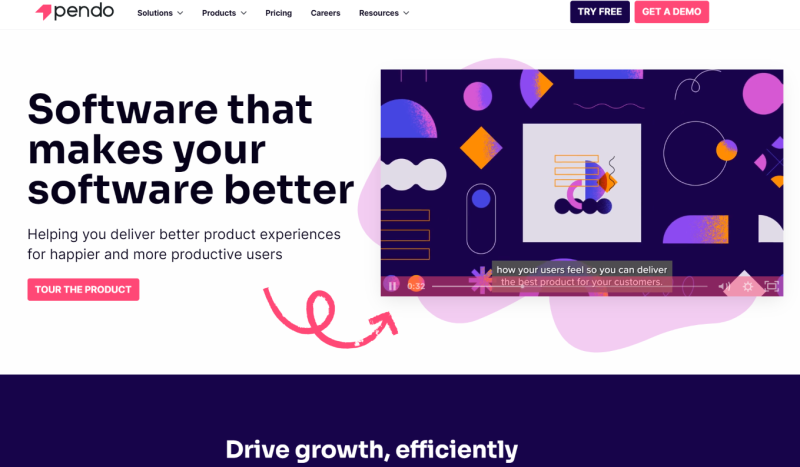
Pendo offers a wide range of tools to help product teams better understand their users. Product analytics, in-app guides, and session replay will give you crucial insights into what real users are doing with your products. When combined with user feedback collected in-app, these insights will help product teams increase transparency, make effective prioritization decisions, and build better products.
Rating: G2 - 4.4 stars.
Pricing: On request.
Free trial: Pendo offers a free tier for up to 500 monthly active users.
Demo: Pendo self-guided demo.
Pros
Supports A/B Testing efforts.
Aids development of better user onboarding experiences.
Detailed reporting.
User-friendly UI.
Cons
Limited mobile app.
Integrations are difficult to set up.
Can be overwhelming at first.
13. Monday
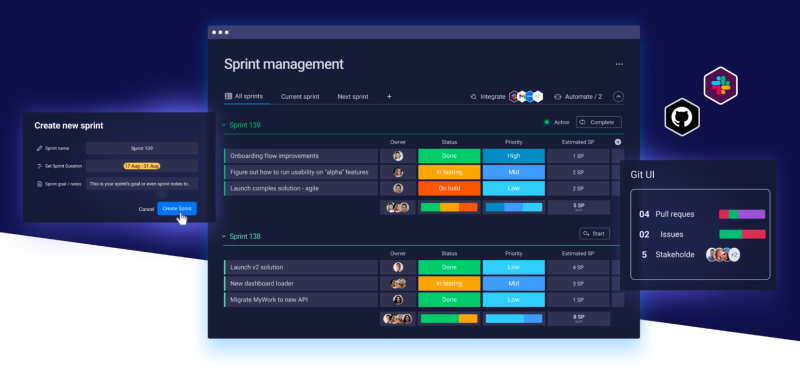
Monday.com offers a highly comprehensive platform for businesses who want to handle tasks and projects in one place, with the flexibility to scale at will. The highly customizable platform allows businesses of all types and sizes to work efficiently. Dashboards that update in real time can be configured to give you the information you need to make key prioritization decisions.
Rating: G2 - 4.7 stars.
Pricing: Free forever tier for up to 2 seats available. Paid plans start at £8 per seat per month.
Free trial: Free trials available on all plans up to Enterprise.
Demo: A Complete monday.com Demo.
Pros
Over 200 automations.
Highly customizable.
Easily generate comprehensive reports.
Easy to use.
Cons
Paid plans have a 3-seat minimum.
Can run slowly and uses a high amount of data.
Poor mobile app.
Automations can be difficult to set up.
Your checklist for choosing a prioritization software
When choosing a product prioritization tool, you want to be certain that it can support your product team by fitting into your existing processes and integrating with your existing tools. You also need to ensure the prioritization software you choose can give you the key insights you need to influence decision-making and facilitate the team in building the best product for your users.
Here’s a checklist with some of the key features you should be looking for when choosing product prioritization software:
1. Easy integration - One of the biggest hurdles when adopting new software is working out how it fits within your current systems. Finding prioritization software that offers integrations with the tools you already use is crucial in ensuring it benefits your business. That’s why airfocus offers a wide range of two-way integrations with software development tools such as Jira, GitHub, and Trello.
2. Built-in prioritization tools - The main draw of product prioritization software is the ability to use a wide range of prioritization tools to fit any situation. airfocus has scoring frameworks, Priority Poker, user insights, and OKRs to help you confidently prioritize roadmaps to backlogs.
3. Priority rating system - A priority rating system helps you and your team objectively rate your items to identify what to focus on next. With the airfocus Priority Ratings app, you can prioritize using our extensive range of tools. Our algorithms will then score your items based on your input and the relative weighting of each criterion. It will then map them all out onto a prioritization chart, allowing you to make informed and objective decisions.
4. Integrated prioritization frameworks - The whole point of investing in product prioritization software is to be able to prioritize within one system. That’s why airfocus has all the prioritization tools and scoring frameworks you could need in one place, so you spend more time focusing on what’s important and less time switching apps.
5. Easy-to-use prioritization templates - Templates and ease of use are crucial for adopting a new platform. You don’t want to spend more time figuring out how something works, especially when using a tool designed to save you time and improve processes.
6. Designed for security - Protecting your IP and data is essential in this digital age. Product information, customer data and financial information leaking can be highly damaging for any business, leading to reputational damage and potentially huge fines for breaching data protection laws. airfocus is ISO 27001:2013 certified with a range of security solutions built in to help you and your customers stay safe.
7. Support product teams of any scale - All businesses hope to grow, so picking prioritization software that can scale as you do is crucial to avoid disruption down the line. As a fully modular platform, airfocus is well suited for teams of any size, from small product teams all the way up to Fortune 500 companies.
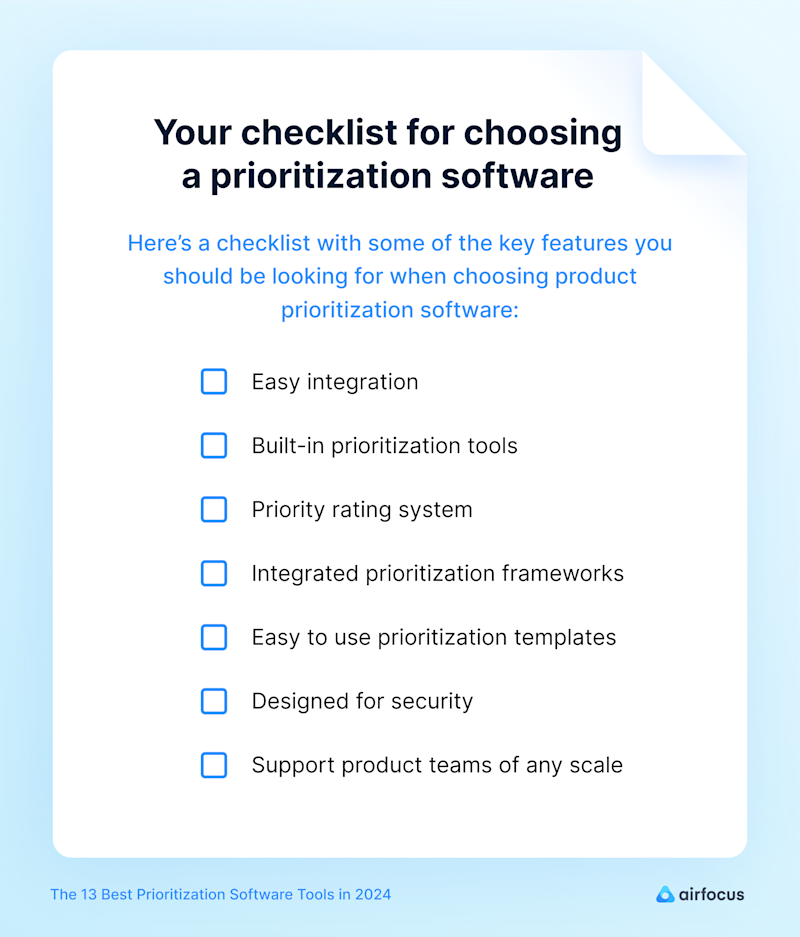
FAQs
Q 1: What is product prioritization?
A 1: Product prioritization is a process that helps teams make effective decisions and plan product development.
Q 2: What are some product prioritization frameworks?
A 2: Weighted Scoring, Value vs. Effort, RICE, Kano Model, and Priority Poker are all common product prioritization frameworks.
Q 3: How do you prioritize your product backlog?
A 3: Product teams should regularly check feedback and groom the backlog to remove any items that are no longer relevant.
Q 4: How do product managers prioritize features?
A 4: Product managers analyze user feedback and business needs to identify the most important features and use a range of prioritization tools to determine which features are most crucial to the user experience.
Q 5: How do you prioritize product tasks?
A 5: A number of techniques can be used to prioritize tasks, including effort-based, impact-based, and customer-satisfaction-based approaches.
How airfocus modular product management platform can help with prioritization

Product management is a constantly changing field and being adaptable is crucial.
Luckily, airfocus allows for flexibility with its modular platform that can be scaled as needed without paying for unnecessary features.
With numerous integrations available, users can continue to use familiar platforms while benefiting from airfocus' features.
The goal of airfocus is to make prioritization easy for all users, whether they are new to product management or experienced. Resources such as the airfocus blog and glossary offer tips, news, and terminology related to product management and prioritization techniques like ICE and MoScOw.
Additional resources
Here are some additional resources on prioritization from our library:
The Mastering Prioritization eBook provides a comprehensive guide to prioritization, from data driven decisions to implementing results.
Enterprise-Grade Prioritization (With Strategies and Examples for Complex Product Portfolios).
Weighted Decision Matrix: A Tool for Pro-level Prioritization.
How To Select the Right Prioritization Framework for Your Product (downloadable).
How to Prioritize Your Product Roadmap (downloadable).
4 Prioritization Exercises To Improve Your Life as a PM (With Product Examples).
The article was first published in January of 2023. Last updated in June 2024.

Malte Scholz
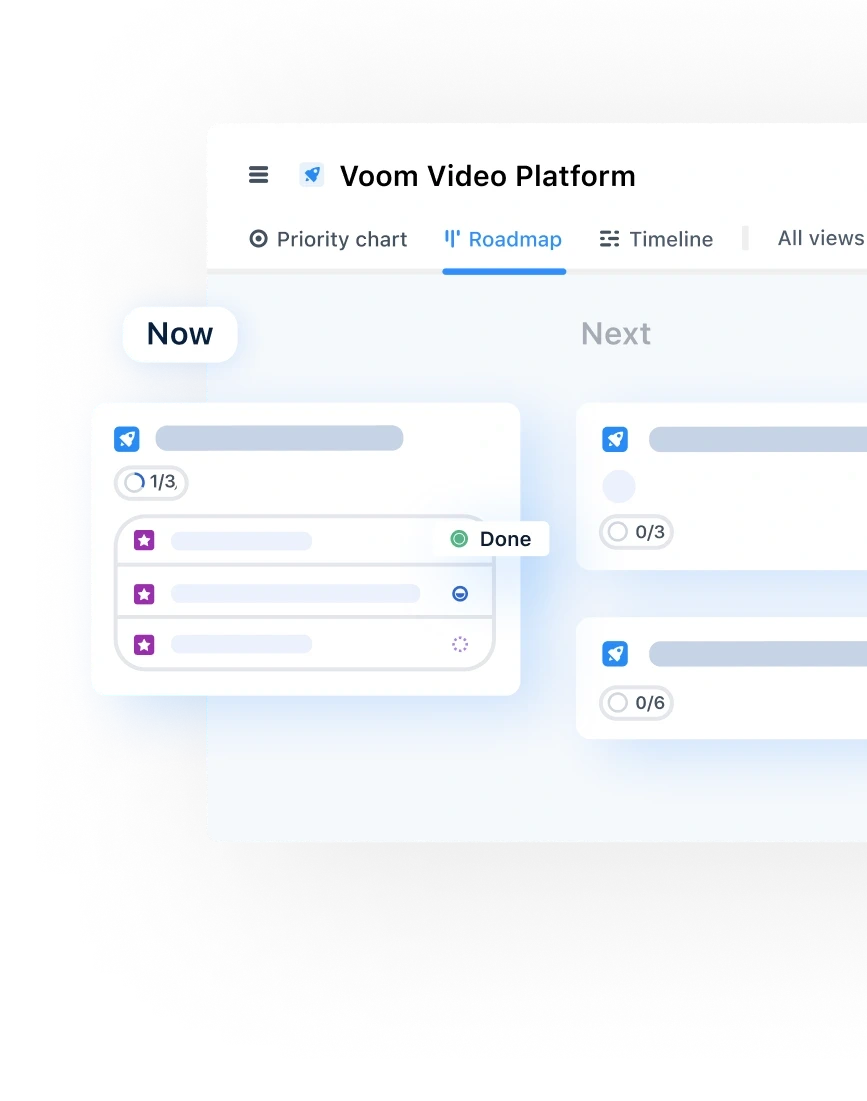
Read also





Prioritize with confidence
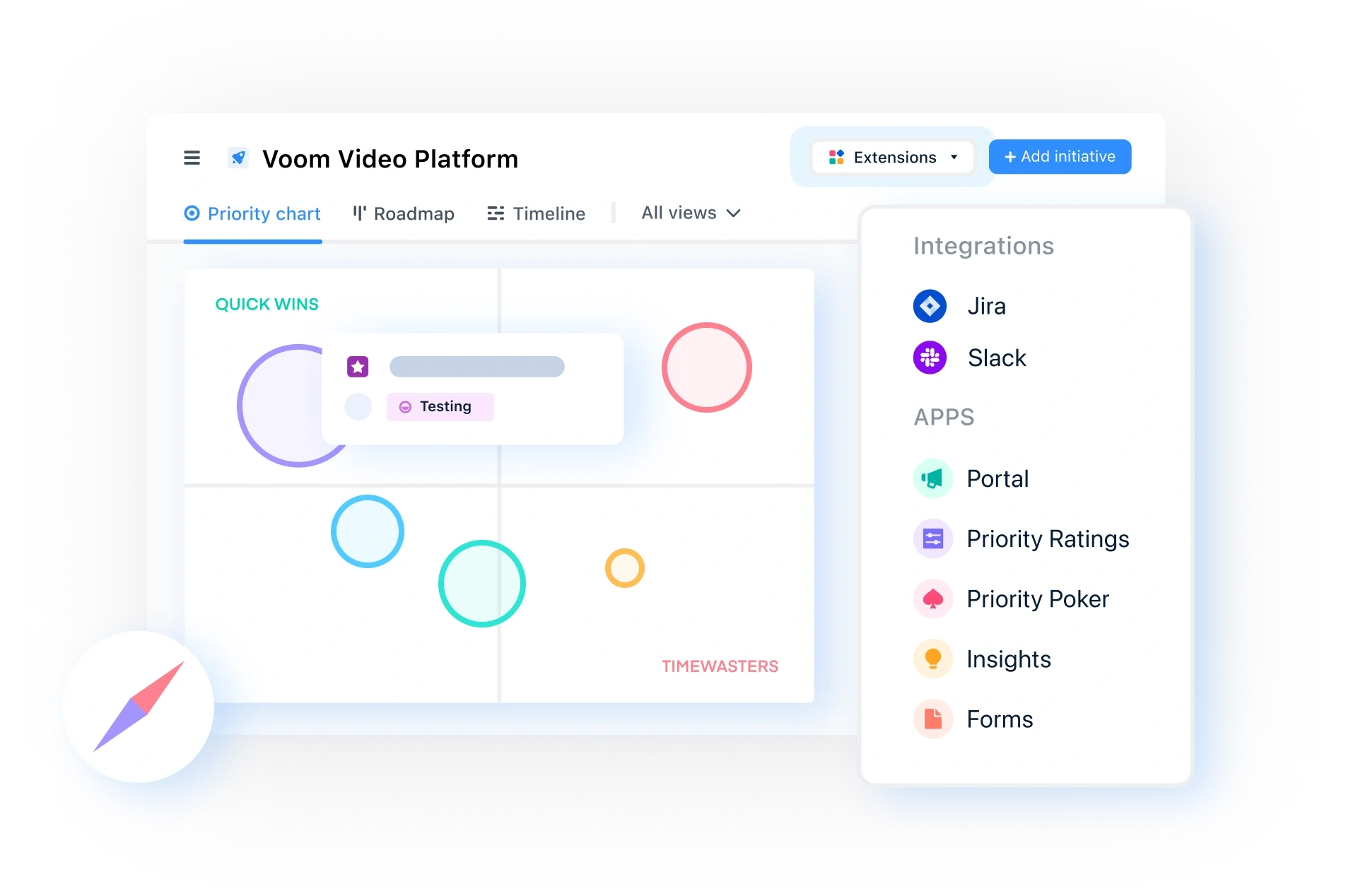
Experience the new way of doing product management
